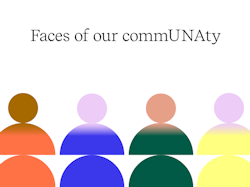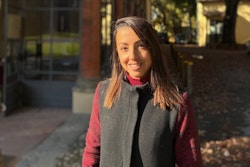Una Europa's vision is to build the University of the Future. Achieving our goals and delivering our ambitions requires enthusiasm and passion, and countless people are working tirelessly behind the scenes, across our community, to make Una Europa a reality.
Enter Faces of our commUNAty - an interview series spotlighting the faces behind Una Europa. Get to know the people that make our community so special, their stories and passions, and help us celebrate the amazing work happening across the alliance and beyond.
Meet Alessandro Seguino and Brian Mather, the faces behind the Una Europa seed-funded project, Virtual Slaughterhouse Simulators
Alessandro Seguino (DVM, DiplECVPH(FS), PFHEA, MRCVS) is project leader of the Virtual Slaughterhouse, an Una Europa seed-funded project. Alessandro is Senior Lecturer in Veterinary Public Health (VPH) and Programme Director of the MSc in Food Safety at the Royal (Dick) School of Veterinary Studies, the University of Edinburgh. His research interests include innovative ways for advancing teaching of veterinary public health for undergraduate and postgraduate students.
Brian Mather is a Senior E-Learning Developer working in the Digital Education Unit at the Royal (Dick) School of Veterinary Studies, where he is responsible for e-learning development and guidance for online postgraduate programmes. He has worked in digital education since 2009 and with the University of Edinburgh since 2013. Prior to his move into education, Brian trained as an industrial designer working in exhibition, furniture, graphic, and web design ,where he developed a unique blend of skills harnessed to create engaging and innovative learning materials for students. His current areas of interest are video production for practical skills teaching, 3D digital modelling and animation for anatomy teaching, virtual reality simulation and digital environments for online students.
Let's get to know Alessandro and Brian and find out about their work in creating the Virtual Slaughterhouse!

Welcome Alessandro and Brian! Let's get started - what can you tell me about the Virtual Slaughterhouse Simulator project?
Brian
The project is based on something Alex and his brother did a while ago, so the concept and all of the work had been done to create an initial kind of architectural simulation of an abattoir. Alex had this teaching requirement and he had developed this thing. I am a digital developer in a department in the vet school called the Digital Education Unit. So it's it's a place to try these things. We work with video, graphics and web stuff and this is a particular interest of mine.
Alex has the virtual slaughterhouse embedded into his teaching. It's a very interactive, digital rather than physical teaching experience, allowing him to take his student through certain things. Because it's a teaching tool, things like PPE and best practice and legislation are really important to include. There is also a lot of interactive elements like being able to "walk" up to an icon and have information appear on the screen, or being able to "speak" to the site manager and pick up a security pass.
" We saw the opportunity to use the Una Europa Seed Funding as a catalyst to take this [project] forward. "
Brian Mather on the Una Europa Seed Funding initiative
How has the project been enriched by collaboration at European level?
Alessandro
The previous version of the visualisation was instrumental for the many vet schools in the UK, as well as in Europe, to graduate their students during the pandemic. We needed to replace real abattoir visits, so I had this tool already available, so I shared for free with all the other vet schools in the UK and any other vet school in Europe to use it. Because of my connections in Europe - I am part of the European College of Veterinary Public Health and other sideways organisations - it was easy for me to create this consortium where we can discuss updates to the simulator at European level.
The idea was not only to find as many partners as possible at European level, but also to have a multidisciplinary approach. There was no point for all of us doing the same thing, that would be a little bit of overkill. So for example from Madrid, we have recruited a pathologist, who basically can show better the diseases of animals. From Berlin, we have an epidemiologist, to show the virology of diseases. And then, colleagues in Helsinki were more focused on food safety. We in Edinburgh are supporting a bit of this and all the other partners have their own area of specific interest. Una Europa offered the opportunity to create a multidisciplinary approach to this problem.

The Virtual Slaughterhouse Simulator covers many different aspects of a visit to an abattoir
Coronavirus brought about a pressing need for digital learning experiences. What other opportunities does the simulator offer?
Alessandro
There are historical root problems with giving students access to the abattoir. These have always existed, the only thing Covid did was to exacerbate and speed up the process.
The first thing is the number of abattoirs are less and less and less so it's more difficult to access, regardless of COVID. Abattoirs are reducing in number all over Europe. If you consider that, for example, in the UK thirty years ago there were more than 1,800 abattoirs, now there are only 250. This can give us a little bit of the scale of change, how difficult it is for veterinary students to actually access the abattoirs.
Secondly, the number of veterinary students is increasing exponentially. Across Europe, there is a requirement to be able to graduate as a vet to visit an abattoir, so sooner or later it will become practically impossible to get all the students through an abattoir. These are the two main drivers, and this is a problem that will not go away, it’s not going to get any better.
Brian
The way I’m trying to build this tool is to include as much accessibility as possible. Across the games industry you might see that there are exceptionally good examples of accommodating your audience, from being able to control the size of text on the screen or being able to control the amount of movement that’s going on. They have been incorporating it, so it makes sense for me to do it as part of development. So we’re accommodating for as much neurodiversity and accessibility as possible.
It really is an amazing opportunity for a much wider audience to be able to access good resources online and for people to consider how they are being accessed, how they’re being used, and really put that at the heart of development.
" [Coronavirus] gave me the opportunity to try and create what are usually hands-on practical teaching elements digitally, to generate as much interactivity and as much user experience as I could without people laying hands on any particular tools. "
Brian Mather on how Coronavirus creates opportunities for innovation
What has the impact of Una Europa been on the project?
Alessandro
From my point of view, the fact that everybody was so enthusiastic. Every time I was talking to people they answered yes straight away. As soon as I contacted people and mentioned Una Europa, I got a straightforward yes. And the collaboration I had from them all was outstanding. I was a bit surprised, to be honest, because on other occasions, in research, it’s difficult to get people to do something. But in this case, it was good.
Brian
Yeah, it's really nice to work with enthusiastic colleagues and people who are really interested in what you have to offer. We were both concerned about the future of our interactions with Europe after Brexit and something like this gives us an opportunity to make sure that everyone knows we still want to be a part of it, we still want to keep these connections going.

The simulator includes many interactive elements such as information points and virtual abattoir staff.
What are the next steps for the virtual slaughterhouse?
Alessandro
With the end of our involvement in the Una Europa See Funding initiative, we are moving into the next stage. Brian and I have always been very enthusiastic - we want to create a virtual chicken abattoir, we want to do a lot of things. We are very motivated, and very open to collaborations!
Brian
Another valuable thing to mention is, this is a tool that is free to anyone who wants to use it. This comes with its own challenges, but we are committed to providing a tool that benefits our humanitarian animal agenda and is available as widely as possible, across Europe.
" Brian and I have always been very enthusiastic... we have a lot of plans, and we are open to collaborations! "
Alessandro on the future of Virtual Slaughterhouse Simulator
And finally, a fun question. If you could visit an Una Europa city for just one day, which would you choose and why?
Brian
I just took a train to France and back because I was trying not to fly. There aren’t many Una Europa destinations that you can get to in one day by train, that’s going to have quite an implication on my willingness to go.
However, if there were a carbo-free way, I haven’t been to Helsinki yet. I also haven’t been to Italy, and I think Alex probably holds that against me.
Alex
For sure, for sure.
In my case, I’ve been to Helsinki,
but it’s cold. I’ve been to Bologna already and I’m Italian, so I can go anytime
I want. I’ve not been to Berlin and neither in Madrid. To be honest, I think I
would prefer Madrid, but just because I’m Italian and I’m used to the good
weather, and good food that is more close to my heart. But I heard that Berlin
is also very nice. If I have to choose, just because of the weather I would say
Madrid.
Want to find out more about Virtual Slaughterhouse Simulator and other projects funded through Una Europa Seed Funding? We have created a database of all seed-funded projects so far, including an overview of each project and a key contact for those interested in collaboration. Browse all our seed-funded projects now!



